Apple MacBook (12-inch, 2015) review: A minimalist MacBook that proves less can be more
Editors’ note (June 27, 2017): The12-inch MacBook, reviewed in full below, was updated in 2016 and then again in June 2017, at Apple’s Worldwide Developers Conference. The new $1,299 12-inch MacBook and $999 13-inch MacBook Air now have faster, more powerful Intel processors. The current crop of MacBook Pros — the $1,299 13-inch, $1,799 13-inch with Touch Bar, and $2,399 15-inch with Touch Bar — have those new chips, too, along with upgraded graphics hardware.
Otherwise, aside from a RAM bump here and a slight price drop there, the 2017 batch is very similar to the one from 2016, with the same enclosures, ports, trackpads and screens. But be forewarned: Buying a new MacBook Pro may require you to invest in a variety of adapters for your legacy devices. Also note that the 13-inch MacBook Pro from 2015 has been discontinued, though the $1,999 15-inch model from that year remains available for those who want all the ports and fewer dongles.
The complaints started even before Apple’s first new MacBook demo ended. During the March 2015 press event, observers fretted about the new, slimmer, lighter 12-inch MacBook. “It’s underpowered,” they said. “The battery life will be short. The new keyboard is too shallow. The no-click touchpad is a gimmick.”
The outcry, which ranged from deriding the new, singular USB-C port to the overall price was reminiscent of the world’s reaction to the original iPad in 2010. And like that groundbreaking tablet, the new 12-inch MacBook won’t do everything and isn’t for everyone. But its strictly enforced minimalism will make this laptop the model that industrial designers will strive to copy for the next several years.
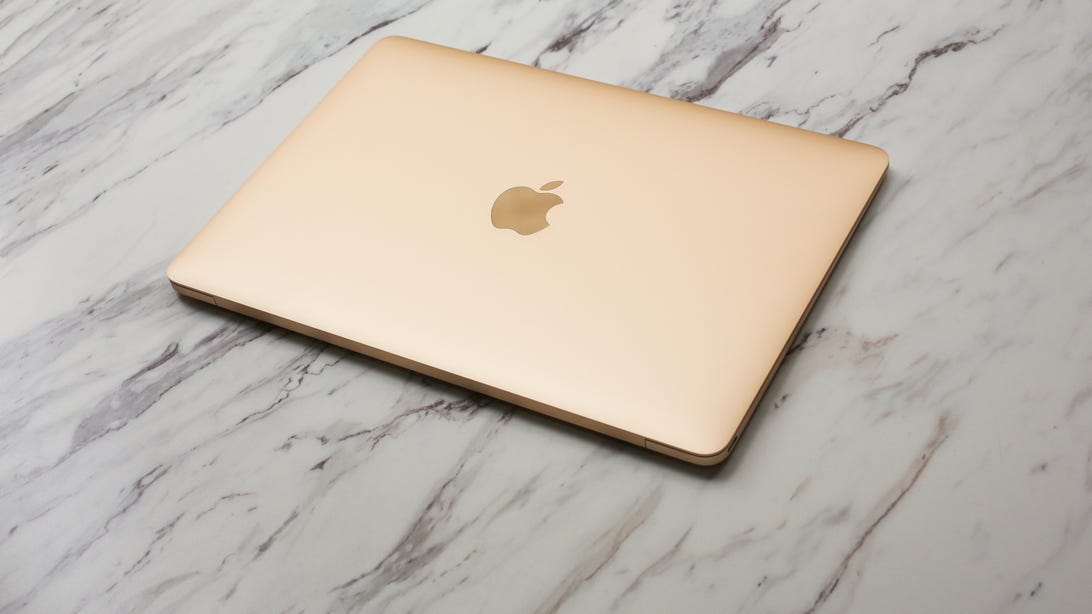
Sarah Tew/CNET
The 12-inch MacBook is a system that ditches the Air and Pro monikers and returns to a simpler designation not seen since the classic black and white polycarbonate MacBooks of the mid-2000s (the ones you still occasionally see in coffee shops despite being their being discontinued in 2011).
Starting at $1,299, it includes a high-resolution Retina screen (much sharper than that on the Air), 8GB of RAM and 256GB of solid state storage. Unlike other laptops with removable drives or RAM, everything here is (permanently) packed into a tiny custom motherboard that leaves maximum room for a large battery. A second version, priced at $1,599, adds a 512GB hard drive and a tiny processor speed bump. In the UK and Australia, the prices start at £1,049 and AU$1,799 for the base model and hit £1,299 and AU$2,199 for the upgrade. More expensive build-to-order models are available, too. (The MacBook can be ordered online at 12:00 a.m. PT tonight, the same time as the Apple Watch, and should be available in store — presumably in limited quantities — on Friday, April 10.)
By way of comparison, the 13-inch MacBook Air starts at $999, but a similar 8GB/256GB configuration will cost the same $1,299. The 13-inch MacBook Pro starts at the same $1,299 as this new MacBook, but with only half the storage. Upgrading that Pro model to the same 8GB/256GB will cost $1,499. And on the Windows side, a Samsung Ativ Book 9 with the same 8GB RAM/256GB flash drive and the same processor — will cost you $1,399 (all prices in US dollars). So, in the context of its main rivals, the MacBook is actually priced rather competitively.
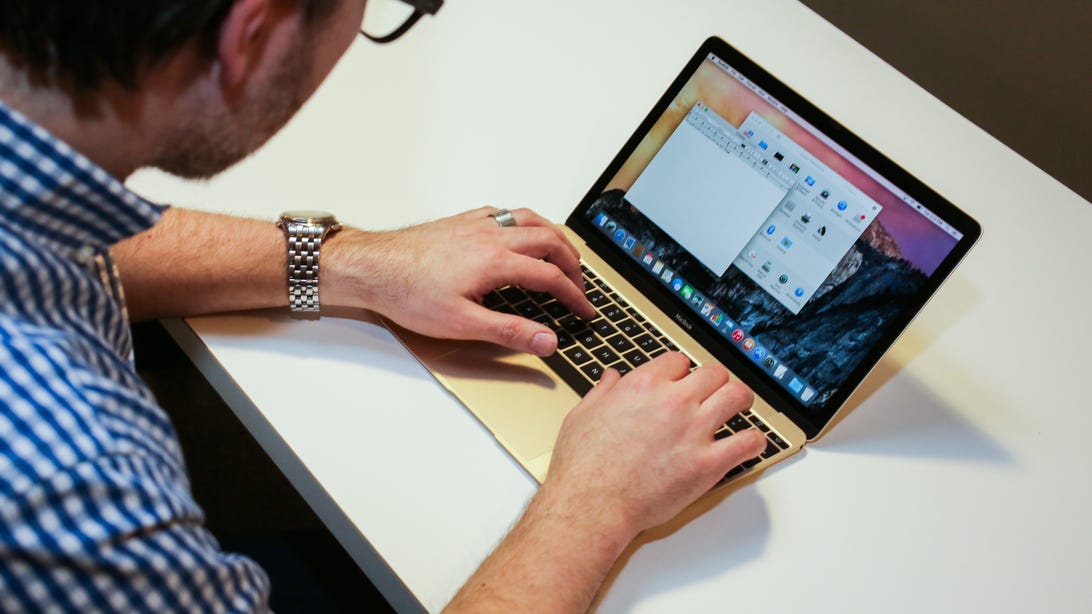
Sarah Tew/CNET
Looking only at a spec sheet, it’s easy to see why this new MacBook might be a tough sell. The MacBook uses Intel’s new Core M processor, designed for slim, light laptops, hybrids and tablets with premium prices. It’s efficient enough that full laptops can even run fanless, allowing for quiet, cool operation. But, the Core M has disappointed in the handful of Windows systems in which we’ve already tested it, turning in sluggish performance and mediocre battery life, the latter an unforgivable flaw for computers designed to be as light and portable as possible.
To spare you the suspense, I can say that the new MacBook performs much better than any other Core M system we’ve tested to date, hitting 11 hours in our video playback test. That’s not nearly as much as you’d get from a MacBook Air or MacBook Pro — and it puts this system at a disadvantage compared to the longest-lasting laptops — but battery life is definitely not the deal-breaker it could have been.
Heavy online use will drain the battery even more quickly, and I found myself frequently glancing up at the upper right corner of the screen to see the battery life percentage tick down as I worked. I’ve found it can last for a full work day of moderate usage, but unlike a current-gen MacBook Pro or Air, it’ll be hard to go a few days without plugging it in at all.
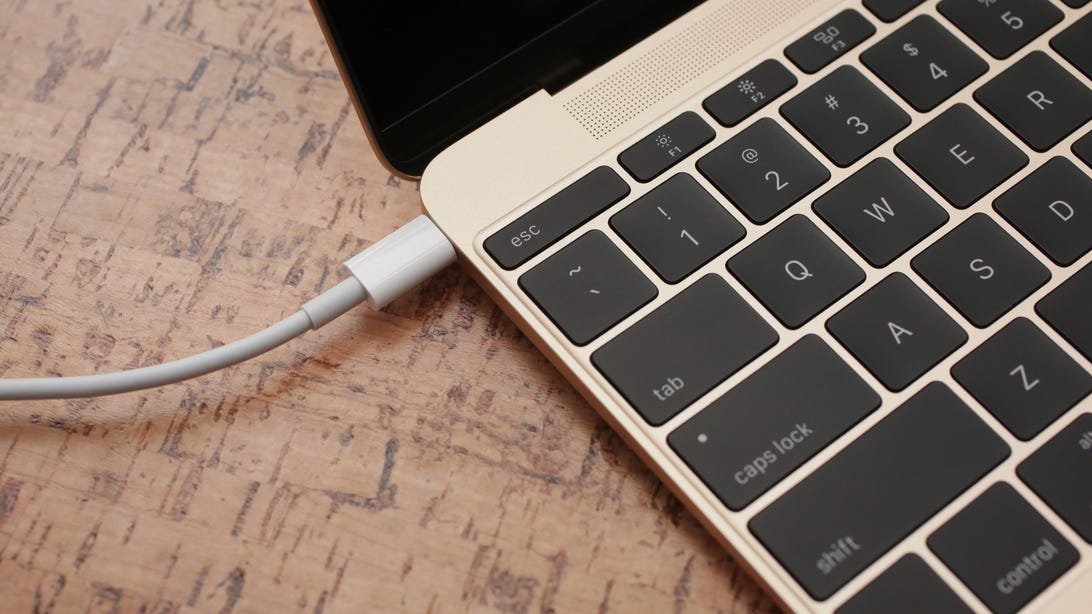
Sarah Tew/CNET
Beyond that, the limitations of having a single USB-C port for all your connection needs (with the exception of a standard audio jack that also made the cut) is even more of a challenge, unless you’re prepared to arm yourself with a pocketful of dongles and adaptors.
Other changes are easier to adapt to. We’ve previously gone into some detail about the new click-free pad, which Apple calls the Force Touch trackpad, which is also available in the updated MacBook Pro. It’s a clever bit of space-saving engineering that replaces the old trackpad, with a hinged design for physically clicking down, with a flat glass surface augmented by a force feedback engine. The keyboard is an even more radical change, swapping out the long-standing Mac standard of deep island-style keys for a set of much shallower keys, but with larger actual key faces.
Using the new MacBook means accepting its limitations, some of which are deliberately self-imposed. That’s especially noticeable when you look at another new laptop, the Samsung Ativ Book 9. It weighs the same as the MacBook, has a similar 12-inch high-res screen, and an Intel Core M processor, but manages to fit in two full-size USB ports and a micro-HDMI output (although it also has a proprietary power connection and lacks USB-C, which is set to become the new standard).
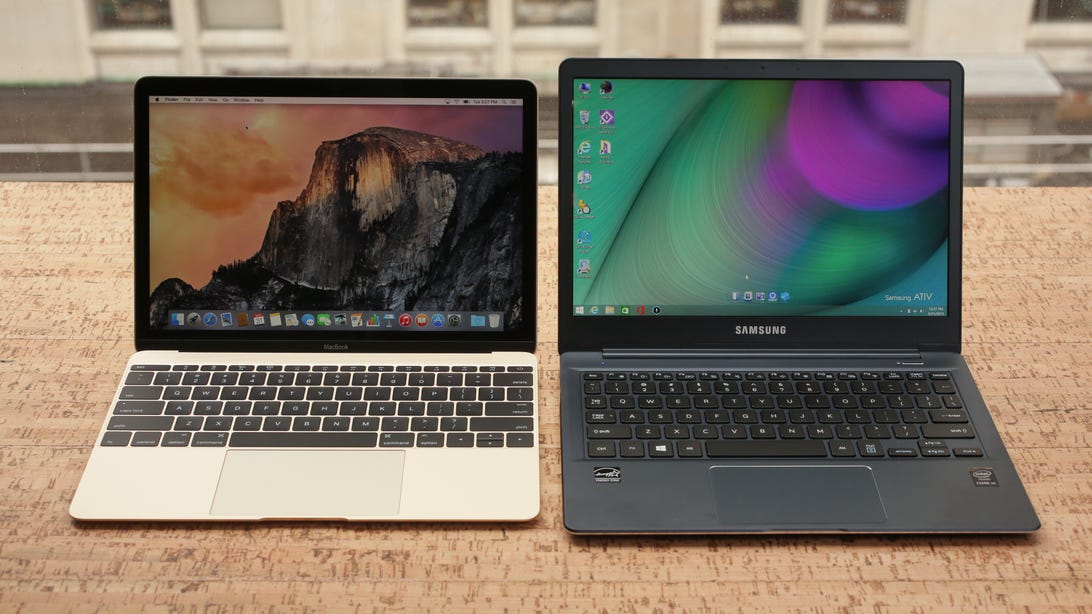
The new MacBook and the similar Samsung Book 9.
Sarah Tew/CNET
If your need for longer battery life, more powerful performance, or more ports doesn’t automatically preclude you, then the in-person experience of using the new MacBook will far outshine the on-paper shortcomings. For writing, Web surfing, video viewing and social media, it’s a pleasure to use, and makes the still-slim 13-inch MacBook Air feel a bit like a lumbering dinosaur, to say nothing of other ultrabook-style laptops. It’s a perfect coffee shop companion.
Some of the critical reactions to this laptop remind me of another new Apple design introduction I covered seven years ago, the original MacBook Air. That system was also criticized for dropping ports and connections, such as an Ethernet and VGA, that people were convinced they still needed. And, much like the new MacBook, it included just a single USB port.
Back in 2008, I was correct that the Air’s new, stripped-down design had real legs, and would set the standard for years to come. But also true was that future refinements down the road would turn the MacBook Air from a speciality product into a mainstream one. When the next 12-inch MacBook update arrives, I suspect it will at the very least add a second USB-C port, and that’s when it will become much easier to recommend to a broader audience.
Apple MacBook (12-inch, 2015)
| Price as reviewed | $1,299, £1,049, AU$1,799 |
|---|---|
| Display size/resolution | 12-inch 2,304×1,440 screen |
| PC CPU | 1.1GHz Intel Core M 5Y31 |
| PC Memory | 8GB DDR3 SDRAM 1,600MHz |
| Graphics | 1,536MB Intel HD Graphics 5300 |
| Storage | 256 SSD |
| Optical drive | None |
| Networking | 802.11ac wireless, Bluetooth 4.0 |
| Operating system | Apple OSX 10.10.2 Yosemite |
Design and features
This is the thinnest Mac that Apple has ever made: at its thickest point it’s just 13.1mm (about half an inch), 24 percent thinner than the existing 11-inch MacBook Air. It’s also the lightest MacBook, at 2.04 pounds (0.9 kg). Samsung’s new Book 9 weighs 2.08 pounds, essentially the same, although it has a slightly larger footprint.
The overall shape and industrial design is familiar, based on the past seven-plus years of MacBook design, but with a few new twists, such as new colors. Besides the traditional silver, the new MacBook also comes in space grey or gold. Our test unit was gold, and like the iPhone color scheme it copies, the coloration is subtle, and gives off the impression that your laptop has a bronzed finish.
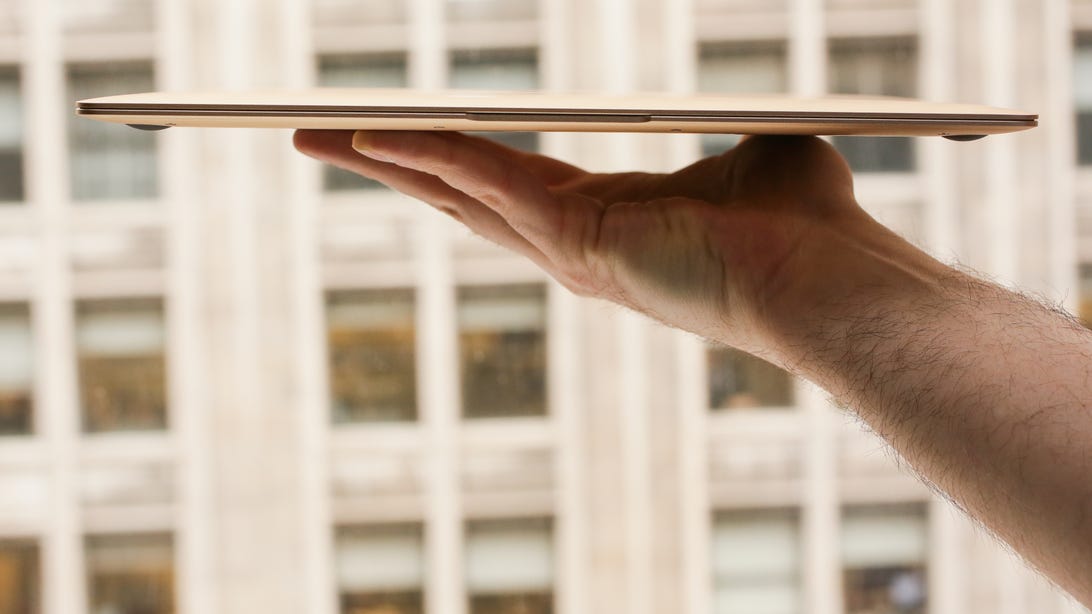
Sarah Tew/CNET
The keyboard, another big change, uses a new butterfly mechanism for keys that’s thinner and more stable. The nearly edge-to-edge keyboard has larger key faces, yes, but the keys are also shallower, barely popping up above the keyboard tray and depressing into the chassis only slightly. It takes some getting used to, especially if you’re accustomed to the deep, clicky physical feedback of the current MacBooks or the similar island-style keyboards of most other modern laptops.
The first time I tried the keyboard, I couldn’t get through even a few sample sentences without several typos, because of the shallow keys and their lower level of tactile feedback. But when I tried again a couple of hours later, it was already much easier.
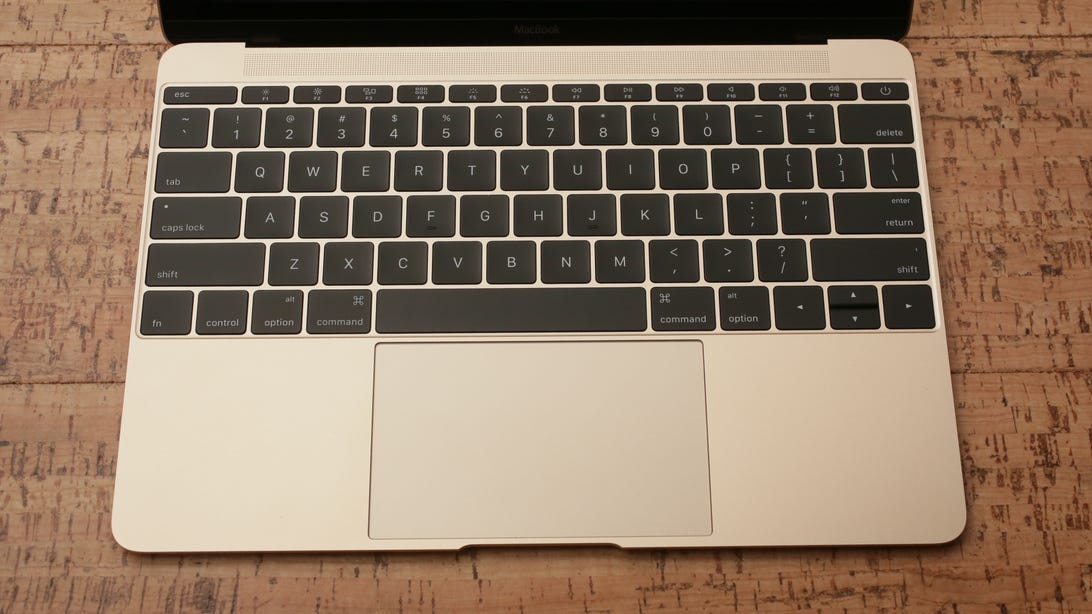
Sarah Tew/CNET
After using the new MacBook keyboard for the better part of a week, the shallowness of the keys, and a lack of a deeply satisfying click still bothers me. But, as someone who types very longform, the larger key faces and rock-solid stability make up for that, tipping the needle into the positive category. The keys are almost completely wobble-free, as opposed to the wiggle you can get under your fingers on a current MacBook keyboard.
The new trackpad, called the Force Touch, is even more of a change. Nearly the same size as the Air’s, but squeezed into a smaller space, it dominates the lower half of the laptop and goes right up to the bottom edge. While previous trackpads had a hinge along the top in a kind of diving board design, the new pad works very differently. We took a deeper hands-on look at Force Touch when we tested it in the only other Apple product to support the new TrackPad right now, the 13-inch MacBook Pro.
Four sensors under the pad allow you to “click” anywhere on the surface, and the Force Click effect, which combines the sensors with haptic (or taptic) feedback, allows you to have two levels of perceived clicking within an app or task. That deep click feels to the finger and brain like the trackpad has a stepped physical mechanism, but in fact, the movement you feel is a small horizontal shift, which, even when fully explained, still feels like you’re depressing the trackpad two levels.
Apple describes it like this: “With the Force Touch trackpad, force sensors detect your click anywhere on the surface and move the trackpad laterally toward you, although the feel is the same familiar downward motion you’re accustomed to in a trackpad.”
With that second, deeper click, you can access several types of contextual information, for example, highlighting a word and getting a Wikipedia pop-up, or seeing a map when deep-clicking on an address. Jumping into the preview view of a document or file works with the deep click, too, just as it does now by pressing the space bar in OS X. The most advanced use is probably fast-forwarding through a video clip in QuickTime, faster or slower, depending on how hard you press down on the trackpad.


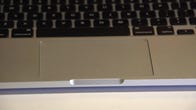
-3.png?width=698&height=393&name=blog%20image%20Salima%20(1)-3.png)